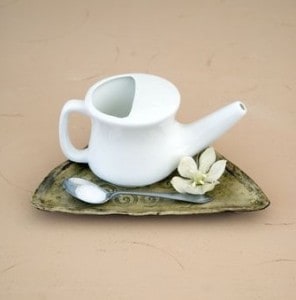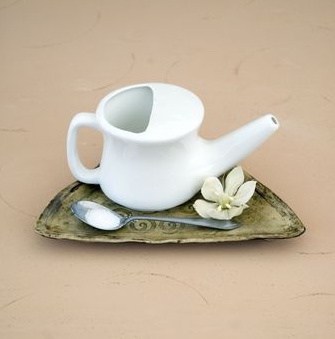The neti pot is the most ancient form of nasal irrigation, originally discovered in India. Traditionally the neti pot has been used in Ayurvedic practice. It is believed that to have free-flowing breath without any blocking of the sinus promotes clear thinking. Yoga practitioners have  known this for centuries and recognise the importance of the free flow of breath in meditation.
known this for centuries and recognise the importance of the free flow of breath in meditation.
Those that suffer from regular sinus problems know all too well the pain, pressure, loss of smell and congestion that interrupts their daily life. Using a neti pot is an effective method to relieve blocking of the sinus, whether an acute sinusitis problem or a stuffy head that accompanies a cold or flu.
While the more chronic sufferers of sinusitis won’t find an all-in-one cure for their more serious symptoms, they certainly will find much needed relief from regular use of the neti pot. It is also a great method to clear the sinus daily to remove irritants and toxins that have been collected and trapped in the nasal cavity from the environment, such as dust, pollen and pollution. The best thing about the neti pot is that it provides lasting relief from sinus problems without the need of pharmaceutical medication such as antihistamines and decongestants. It is a practice that can be carried out daily, that is safe and poses no harmful side effects.
How does it work?
 Using the neti pot to pour a sterile saline solution into one nostril, the neti pot relies on head positioning and gravity for effective results. The solution travels through your navel cavity and to your other nostril, which flushes out any trapped particles, debris and mucus. You then repeat the process on the opposite nostril. The nasal cavity contains tiny hair-like structures which collect bacteria and other unwanted particles. Once the hairs capture the particles, they are forced to the back of the throat where they are swallowed and taken care of by your stomach acid.
Using the neti pot to pour a sterile saline solution into one nostril, the neti pot relies on head positioning and gravity for effective results. The solution travels through your navel cavity and to your other nostril, which flushes out any trapped particles, debris and mucus. You then repeat the process on the opposite nostril. The nasal cavity contains tiny hair-like structures which collect bacteria and other unwanted particles. Once the hairs capture the particles, they are forced to the back of the throat where they are swallowed and taken care of by your stomach acid.
The neti pot has been known to the Western world for well over a century, however much like other popular Eastern traditions, it hasn’t been used in practice until recent times. These days you will even find ear, nose and throat (ENT) surgeons recommending irrigation with a neti pot for their patients who have recently undergone surgery, to clear dead tissue from their nostrils. Many other general practitioners and pharmacies will also recommend the neti pot for patients suffering blocked sinuses.
Neti pots can be found at most speciality health food stores and local pharmacies. They should include a detailed instruction guide on how to use. However, it is also a good idea to research online for videos displaying the practice of nasal irrigation with the neti pot, in particular guides for troubleshooting and tips for expelling remaining saline solution.
Resources: Himalayan Institute Neti Pot Guide: www.himalayan.wpengine.netdna-cdn.com/wp-content/uploads/2012/01/Neti-Pot-Safety-Guide.pdf




Leave A Comment